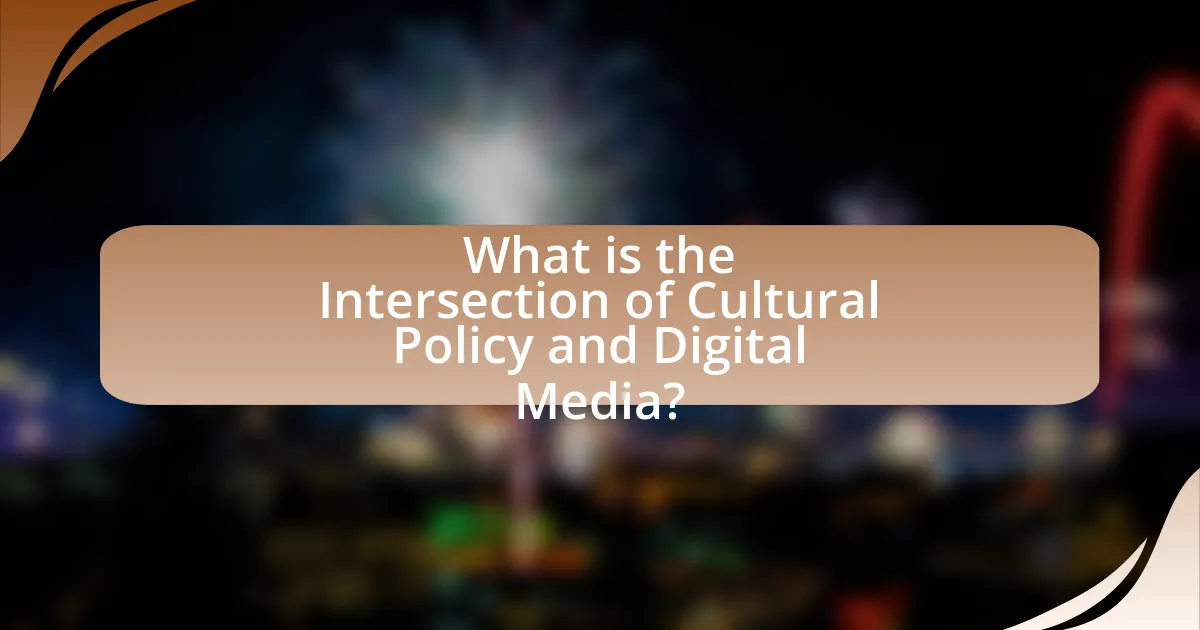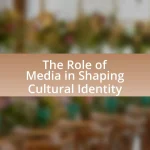The article analyzes the intersection of cultural policy and digital media, highlighting how governmental frameworks influence digital content production, distribution, and consumption. It discusses key components of cultural policy, such as access, preservation, content creation, and regulation, and their impact on digital media landscapes. The article also addresses the significance of cultural policies in promoting diversity, the challenges posed by copyright and access disparities, and the role of digital platforms in shaping cultural narratives. Additionally, it explores current trends, successful adaptations of policies, and strategies for stakeholders to engage effectively in this evolving digital environment.

What is the Intersection of Cultural Policy and Digital Media?
The intersection of cultural policy and digital media refers to the ways in which governmental and institutional frameworks for culture influence and are influenced by digital media technologies and practices. Cultural policy shapes the production, distribution, and consumption of digital content, ensuring that diverse cultural expressions are accessible and supported in the digital realm. For instance, policies promoting digital literacy and access to technology can enhance public engagement with cultural content, while regulations on copyright and intellectual property directly affect how digital media is created and shared. This relationship is evidenced by initiatives like the European Union’s Digital Single Market strategy, which aims to facilitate cross-border access to digital content while preserving cultural diversity.
How do cultural policies influence digital media landscapes?
Cultural policies significantly influence digital media landscapes by shaping content creation, distribution, and consumption practices. These policies can promote local cultural industries, ensuring that diverse voices and narratives are represented in digital media. For instance, the European Union’s Audiovisual Media Services Directive mandates that streaming platforms allocate a percentage of their content to European works, thereby fostering local talent and cultural expression. Additionally, cultural policies can regulate copyright laws and digital rights management, impacting how media is shared and monetized online. Such regulations can either encourage innovation and accessibility or create barriers for emerging creators, ultimately shaping the overall digital media ecosystem.
What are the key components of cultural policy in relation to digital media?
The key components of cultural policy in relation to digital media include access, preservation, content creation, and regulation. Access ensures that diverse populations can engage with digital media, promoting inclusivity and equity. Preservation focuses on safeguarding digital cultural heritage, as evidenced by initiatives like the Digital Public Library of America, which aims to provide access to cultural resources. Content creation emphasizes supporting artists and creators in the digital space, fostering innovation and cultural expression. Regulation addresses issues such as copyright, privacy, and digital rights, ensuring that cultural policies adapt to the evolving digital landscape. These components collectively shape how societies interact with and benefit from digital media.
How do these components shape the creation and distribution of digital content?
Cultural policy components significantly shape the creation and distribution of digital content by establishing frameworks that influence content production, accessibility, and dissemination. These policies dictate funding allocations, copyright regulations, and content standards, which directly affect what types of digital content are produced and how they reach audiences. For instance, government initiatives that support local content creation can lead to a diverse range of digital media that reflects cultural identities, while stringent copyright laws can limit the sharing and remixing of existing content, thereby impacting distribution channels. Additionally, policies promoting digital literacy can enhance audience engagement and content consumption, further shaping the digital landscape.
Why is the intersection of cultural policy and digital media significant?
The intersection of cultural policy and digital media is significant because it shapes how cultural content is created, distributed, and consumed in the digital age. Cultural policy influences the regulatory frameworks that govern digital platforms, ensuring diverse representation and access to cultural resources. For instance, policies promoting local content can enhance cultural diversity online, as seen in countries like Canada, where regulations support Canadian content in broadcasting. This intersection also addresses issues of copyright, digital rights, and the preservation of cultural heritage, which are crucial for maintaining cultural identity in a rapidly evolving digital landscape.
What cultural values are reflected in digital media policies?
Digital media policies reflect cultural values such as freedom of expression, inclusivity, and the protection of cultural heritage. These policies often prioritize the right to share diverse viewpoints, which is essential in democratic societies, as seen in the First Amendment of the U.S. Constitution that safeguards free speech. Additionally, inclusivity is emphasized through regulations that promote access to digital content for marginalized communities, aligning with global initiatives like the United Nations’ Sustainable Development Goals that advocate for equitable access to information. Furthermore, the preservation of cultural heritage is evident in policies that support the digitization of cultural artifacts, ensuring that diverse cultural narratives are maintained and accessible, as highlighted by UNESCO’s efforts in promoting cultural diversity in the digital age.
How does this intersection impact cultural diversity in digital platforms?
The intersection of cultural policy and digital media significantly enhances cultural diversity on digital platforms by promoting inclusive content and representation. Cultural policies often aim to protect and promote diverse cultural expressions, which, when integrated into digital media, lead to a wider array of voices and narratives being shared online. For instance, the European Union’s Audiovisual Media Services Directive encourages member states to support local content production, resulting in a richer tapestry of cultural offerings available on platforms like Netflix and YouTube. This policy-driven approach not only fosters the visibility of underrepresented cultures but also encourages cross-cultural exchanges, thereby enriching the overall digital landscape.
What challenges arise at the intersection of cultural policy and digital media?
Challenges at the intersection of cultural policy and digital media include issues of copyright, access, and representation. Copyright laws often struggle to keep pace with the rapid evolution of digital media, leading to conflicts over intellectual property rights. Access disparities arise as not all communities have equal opportunities to engage with digital platforms, which can exacerbate cultural inequalities. Additionally, representation in digital media can be skewed, as marginalized voices may be underrepresented or misrepresented, impacting cultural narratives. These challenges highlight the need for adaptive policies that address the complexities of digital landscapes while promoting inclusivity and equity in cultural expression.
What are the legal and ethical considerations in digital media regulation?
Legal and ethical considerations in digital media regulation include issues of copyright, privacy, freedom of expression, and the responsibility of platforms to manage harmful content. Copyright laws protect creators’ rights, ensuring they receive recognition and compensation for their work, while privacy regulations, such as the General Data Protection Regulation (GDPR), safeguard users’ personal information. Freedom of expression is a fundamental right that must be balanced against the need to prevent hate speech and misinformation. Additionally, platforms face ethical responsibilities to monitor and regulate content to protect users from harm, as seen in various legal frameworks worldwide that impose obligations on digital service providers to address illegal content. These considerations are crucial for maintaining a fair and just digital environment.
How do technological advancements complicate cultural policy implementation?
Technological advancements complicate cultural policy implementation by introducing rapid changes in media consumption and production, which often outpace regulatory frameworks. For instance, the rise of digital platforms has led to challenges in enforcing copyright laws, as traditional policies struggle to address issues like content sharing and user-generated material. Additionally, the global nature of the internet complicates jurisdictional enforcement, making it difficult for local cultural policies to be effectively applied across different regions. This complexity is evidenced by the European Union’s ongoing efforts to regulate digital content through the Digital Services Act, which aims to address these challenges but faces criticism for being insufficiently adaptable to the fast-evolving digital landscape.
How can stakeholders navigate the intersection of cultural policy and digital media?
Stakeholders can navigate the intersection of cultural policy and digital media by actively engaging in collaborative frameworks that promote dialogue and understanding between cultural institutions and digital platforms. This approach is essential as it allows stakeholders to address the challenges posed by rapid technological advancements while ensuring the preservation of cultural heritage. For instance, the European Union’s Digital Single Market strategy emphasizes the importance of balancing copyright laws with the need for innovation in digital media, demonstrating a successful model of stakeholder collaboration. By participating in policy discussions and leveraging data-driven insights, stakeholders can effectively influence cultural policies that adapt to the evolving digital landscape.

What are the current trends in Cultural Policy and Digital Media?
Current trends in Cultural Policy and Digital Media include the increasing emphasis on digital inclusion, the promotion of cultural diversity, and the integration of technology in cultural practices. Digital inclusion focuses on ensuring equitable access to digital resources, particularly for marginalized communities, as evidenced by initiatives like the European Union’s Digital Single Market strategy, which aims to enhance access to digital content across member states. Cultural diversity is being prioritized through policies that support the representation of various cultural identities in digital media, reflecting global movements towards inclusivity. Additionally, the integration of technology is transforming how cultural institutions engage with audiences, as seen in the rise of virtual exhibitions and online performances, which gained prominence during the COVID-19 pandemic and continue to shape audience experiences.
How are governments adapting cultural policies to digital media changes?
Governments are adapting cultural policies to digital media changes by implementing regulations that address copyright issues, promote digital literacy, and support the creative economy. For instance, many countries have updated their copyright laws to protect digital content creators and ensure fair compensation, reflecting the shift from traditional media to online platforms. Additionally, initiatives aimed at enhancing digital literacy among citizens are being introduced to equip them with the skills necessary to navigate the digital landscape effectively. According to a report by UNESCO, over 80% of countries have developed or are in the process of developing national strategies for digital literacy, demonstrating a global commitment to adapting cultural policies in response to digital media evolution.
What examples illustrate successful adaptations of cultural policy in the digital age?
Successful adaptations of cultural policy in the digital age include the European Union’s Copyright Directive, which aims to modernize copyright laws to better protect creators in the online environment. This directive, implemented in 2019, addresses issues such as fair compensation for artists and the regulation of content-sharing platforms. Additionally, the UK’s Creative Industries Sector Deal promotes digital innovation and collaboration among cultural institutions, enhancing access to cultural content through digital platforms. These examples demonstrate how cultural policies are evolving to meet the challenges and opportunities presented by digital media, ensuring that cultural heritage and creative industries thrive in a digital landscape.
How do international cultural policies differ in addressing digital media?
International cultural policies differ significantly in their approaches to addressing digital media, primarily influenced by national priorities, regulatory frameworks, and cultural contexts. For instance, the European Union emphasizes the protection of cultural diversity and intellectual property rights in digital spaces, as seen in initiatives like the Digital Single Market strategy, which aims to enhance access to digital content while safeguarding creators’ rights. In contrast, countries like China implement stringent controls over digital media to maintain state censorship and promote national narratives, reflecting a focus on political stability and cultural conformity. These differences highlight how cultural policies are shaped by varying objectives, such as economic growth, cultural preservation, and political control, leading to diverse regulatory environments and support mechanisms for digital media across different nations.
What role do digital platforms play in shaping cultural policy?
Digital platforms significantly influence cultural policy by providing new avenues for content creation, distribution, and engagement. These platforms enable diverse voices to participate in cultural discourse, often leading to shifts in policy priorities that reflect contemporary societal values. For instance, social media platforms have been instrumental in mobilizing public opinion around cultural issues, as seen in movements like #MeToo and Black Lives Matter, which have prompted legislative changes and policy discussions. Additionally, digital platforms facilitate access to cultural content, impacting funding decisions and resource allocation in cultural sectors. This dynamic interaction between digital platforms and cultural policy underscores the necessity for policymakers to consider the implications of digital media in their frameworks.
How do major digital platforms influence cultural policy decisions?
Major digital platforms influence cultural policy decisions by shaping public discourse, determining content visibility, and providing data-driven insights to policymakers. These platforms, such as Facebook, Google, and Twitter, control significant portions of information dissemination, which affects how cultural narratives are constructed and perceived. For instance, algorithms prioritize certain types of content, impacting which cultural issues gain traction and which do not, thereby influencing policy agendas. Additionally, these platforms often engage in lobbying efforts to sway regulations in their favor, as seen in the European Union’s Digital Services Act discussions, where tech companies advocated for favorable terms regarding content moderation and user data. This interplay between platform policies and cultural governance highlights the significant role that digital entities play in shaping cultural policy frameworks.
What responsibilities do digital platforms have in promoting cultural policies?
Digital platforms have the responsibility to actively promote cultural policies by facilitating access to diverse cultural content and supporting local creators. These platforms can achieve this by implementing algorithms that prioritize cultural diversity, ensuring equitable representation of various cultural narratives, and providing tools for creators to share their work. For instance, platforms like YouTube and Spotify have initiatives aimed at promoting local artists and cultural events, which aligns with cultural policy goals of fostering creativity and cultural exchange. Additionally, research indicates that digital platforms can influence cultural consumption patterns, making their role in promoting cultural policies crucial for sustaining cultural heritage and diversity in the digital age.
What future developments can we expect at the intersection of cultural policy and digital media?
Future developments at the intersection of cultural policy and digital media will likely include enhanced regulatory frameworks that address issues such as copyright, data privacy, and digital access. As digital media continues to evolve, cultural policies will adapt to ensure equitable access to cultural content and protect creators’ rights. For instance, the European Union’s Digital Services Act aims to create a safer digital space, which reflects a growing recognition of the need for policies that govern online platforms. Additionally, there will be an increased focus on promoting digital literacy and cultural diversity, as governments and organizations recognize the importance of fostering inclusive digital environments that reflect diverse cultural narratives. These developments are driven by the rapid growth of digital platforms and the need for policies that can effectively manage the complexities of cultural expression in a digital age.

How can stakeholders effectively engage with the intersection of Cultural Policy and Digital Media?
Stakeholders can effectively engage with the intersection of Cultural Policy and Digital Media by fostering collaborative partnerships that align cultural objectives with digital innovation. This engagement can be achieved through initiatives such as public consultations, where stakeholders gather input from diverse community members to shape policies that reflect cultural values while leveraging digital platforms for broader outreach. For instance, the European Commission’s “Digital Single Market” strategy emphasizes the importance of integrating cultural heritage with digital technologies, demonstrating how policy frameworks can adapt to the evolving digital landscape. By utilizing data analytics and audience insights, stakeholders can tailor cultural content to meet the needs of digital consumers, ensuring that cultural policies remain relevant and impactful in a digital age.
What best practices should stakeholders follow in this intersection?
Stakeholders should prioritize collaboration, transparency, and inclusivity in the intersection of cultural policy and digital media. Collaboration among diverse stakeholders, including government, cultural institutions, and digital platforms, fosters a holistic approach to policy-making that reflects varied perspectives and needs. Transparency in decision-making processes builds trust and ensures accountability, while inclusivity guarantees that marginalized voices are heard and considered, leading to more equitable outcomes. Research indicates that inclusive cultural policies enhance community engagement and participation, ultimately enriching the cultural landscape and promoting sustainable digital practices.
How can cultural institutions leverage digital media for policy advocacy?
Cultural institutions can leverage digital media for policy advocacy by utilizing social media platforms, online campaigns, and digital storytelling to engage audiences and influence policymakers. These institutions can create compelling content that highlights the importance of cultural policies, reaching wider audiences and mobilizing support. For instance, the National Endowment for the Arts reported that social media campaigns can increase public awareness and participation in cultural initiatives, demonstrating the effectiveness of digital outreach in shaping policy discussions. By sharing success stories and data-driven insights through digital channels, cultural institutions can effectively advocate for policies that support the arts and culture sector.
What strategies can be employed to foster collaboration between policymakers and digital media creators?
To foster collaboration between policymakers and digital media creators, establishing regular communication channels is essential. These channels can include forums, workshops, and collaborative projects that allow both parties to share insights and objectives. For instance, initiatives like the Creative Industries Council in the UK have successfully brought together government representatives and digital media professionals to discuss policy impacts and creative opportunities. Additionally, creating joint task forces can help align goals, ensuring that digital media creators’ needs are considered in policymaking processes. Evidence from the European Commission’s “Digital Single Market Strategy” highlights the importance of stakeholder engagement in shaping effective policies that support digital innovation.










